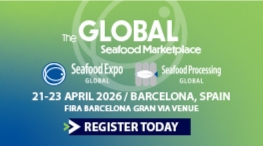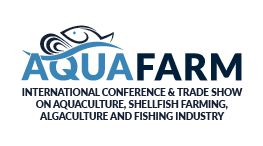This article was featured in Eurofish Magazine 5 2025.
Multi-use platforms may support renewable energy production, food security, biodiversity, and climate resilience at a single site, thereby relieving some of the pressure on marine ecosystems and potentially offering a path to more sustainable ocean practices.
The ocean is becoming an overlooked battleground, where human interests compete for limited space and resources. Shipping lanes crisscross waters increasingly crowded with offshore wind farms, oil rigs, and aquaculture pens, while commercial fishing fleets chase often dwindling stocks. At the same time, climate change is jeopardising marine habitats, threatening biodiversity and global food supplies. Marine Multi-Use Platforms (MUPs) may offer a solution to these sometimes conflicting activities and their impacts. MUPs bring together activities from different sectors in one place to make more efficient use not only of ocean space, but also of infrastructure, services, and personnel. MUPs represent a shift from traditional sector-specific development towards more integrated approaches, potentially creating synergies between energy production, food provision, biodiversity enhancement, and more.
Wind, aquaculture and biodiversity at the same site
The European research project OLAMUR explores the coexistence of offshore wind farms with low-trophic aquaculture (LTA), e.g. bivalve aquaculture, through multiple pilot cases such as WIN@Sea. This project analyses how offshore wind farms can share space with LTA, such as mussel and seaweed farming and national monitoring of the marine environment, while also investigating whether the wind farm foundations (i.e. scour protection) serve as artificial reefs.
MUPs can host a variety of industries, but one of the most common combinations pairs offshore wind energy production with LTA[8]: the production of non-fed species such as seaweed and mussels. Such MUPs feature wind turbines with lines of mussel and seaweed growing between the turbines (Figure 1). Beneath the turbines, rocks placed around turbine foundations – known as scour protection – prevent seabed erosion and serve as artificial reefs[2], over time likely developing marine life and boosting local biodiversity. MUPs can act as symbiotic systems, where renewable energy, sustainable aquaculture, and biodiversity enhancement support one another. Offshore wind farms often create marine refuges by restricting fishing, allowing ecosystems to recover from commercial exploitation[4]. Beyond potentially supporting marine life, MUPs like those studied by the WIN@sea project have the potential to drive economic growth and create jobs[4]. Renewable energy and aquaculture are central to the EU Blue Growth strategy, which aims to improve resource efficiency, create jobs, and promote a sustainable ocean economy, all while improving biodiversity[6].
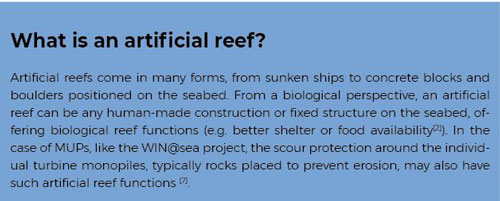
Seaweed and mussel farming regenerating ecosystems
LTA may produce some of the most affordable and ecologically sustainable food products[5], requiring no arable land, freshwater, or fertilisers. Moreover, it supports natural ecosystems and mitigates eutrophication. Mussels, sometimes termed the “intestines” of coastal ecosystems, naturally filter suspended particles, algae, bacteria, and even microplastics, while seaweed acts as a natural biofilter, absorbing excess nutrients such as nitrates and phosphates and thereby improving water quality. Seaweed can also serve as a carbon sink, capturing and storing atmospheric CO₂. Through photosynthesis, seaweeds assimilate carbon dioxide and release oxygen, increasing local oxygen concentrations and slightly raising pH, potentially helping to counteract local ocean acidification. Farmed seaweed can create underwater canopies resembling “forests”, offering temporary shelter and nursery grounds for some marine species.
By cultivating species such as Mytilus sp. (blue mussels) and Saccharina latissima (sugar kelp) (Figure 2), the WIN@sea project demonstrates how aquaculture can deliver both environmental and nutritional benefits. Beyond their environmental role, both mussels and seaweed show promise as sustainable ingredients in animal feed, offering a lower-impact alternative to conventional protein sources. Through their ecological benefits and contribution to food security, the combination of mussel and seaweed farms may serve as a scalable and resilient component of MUPs for sustainable ocean development, benefiting people, the economy, and the planet. On a commercial scale, these “floating” farms may support the fight against climate change and ocean degradation.
When windmills become reefs
Driven by the EU’s climate and energy pledges, Europe’s offshore wind capacity is set to expand in the coming decades[1]. Offshore wind farms are often built on a sandy seabed, which is vulnerable to erosion from currents, threatening the stability of the monopiles and offering limited shelter for animals[7]. When scour protections are placed where natural hard substrates once existed, they may function as reefs, restoring lost ecological functions and supporting life across the food web[7]. These rocky surfaces provide substrate for sessile organisms that help filter water, absorb nutrients, and create shelter. Smaller species like fish and crabs settle there, potentially food for larger predators such as eider ducks, seals and porpoises. Over time, a food web may form, resembling the dynamics found on natural reefs.
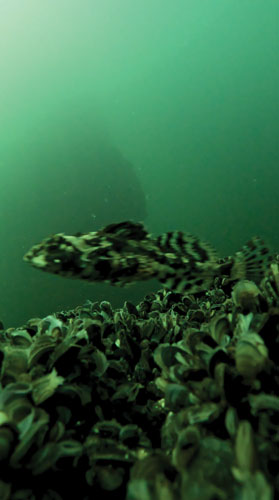
Scour protection around a wind turbine at the Win@Sea project. Small mussels and a fish can be seen.
The photo was taken with an underwater camera placed on the seabed to study marine life
on the reefs around the turbine foundations.
Commercially important species like mackerel (Scomber scombrus) and Atlantic cod (Gadus morhua) are often found lingering near offshore structures, likely drawn by the new feeding grounds[3]. This suggests that scour protection could play a role in supporting the recovery of various marine species. Projects like WIN@sea provide real-world insights by studying how existing offshore wind structures interact with the marine environment. In the Baltic Sea, the WIN@sea project aims to document the species communities that settle on the monopiles and the surrounding scour protection. The project will offer a better understanding of how wind farms can influence local biodiversity.
Understanding the risks and challenges
At a time when the world races to balance sustainability with economic and technological growth, MUPs could become a game-changer in marine -contexts. But they face several hurdles. First, regulatory barriers can stall development. Combining activities such as offshore wind energy and aquaculture is often challenging, as each sector typically operates under its own regulatory and operational standards[8]. For example, Danish marine spatial planning assigns separate zones for wind energy and shellfish farming, which can make combined licensing costly and difficult. In contrast, seaweed cultivation remains unassigned to specific zones, as the industry is still young and limited. Regulatory mismatches can make coordination difficult, delaying approvals and complicating potential MUP developments[8].
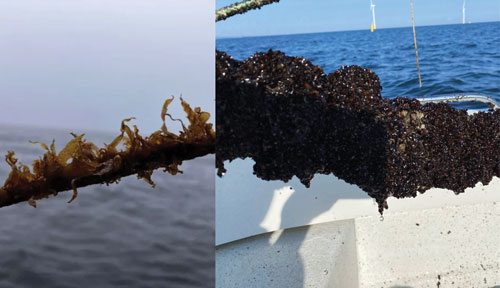
Figure 2: The cultivation of sugar kelp (left) and blue mussels (right) in the WIN@Sea project.
Both species are grown on lines of rope that are suspended in the water.
MUPs may also introduce environmental disruptions. Wind farms can lead to habitat loss, collision risks for marine mammals and birds, and disruption of migratory routes. The installation of scour protections may attract new species to the area and thereby change local biodiversity. However, by covering soft sediments with rocks, scour protection may transform relatively homogenous seascapes, such as sandy seabed, into boulder reef-like habitats, a shift that favours certain species and could displace equally valuable communities adapted to sandy seabed. From a strict conservation perspective, this may not be desirable. Moreover, underwater noise pollution and electromagnetic fields emitted by power cables[7] may pose additional threats to marine species.
Aquaculture brings its own set of challenges. Storms, harvesting, or maintenance can cause mussel shells and dead individuals to fall to the bottom, potentially altering seabed composition. Mussels also produce bio-deposits that might reduce oxygen levels locally. However, in offshore areas like Krieger’s Flak, where the WIN@sea project is located, strong currents help disperse these, minimising the risk. Seaweed farms may release organic matter or attenuate light, yet with suitable management, these effects are limited. In Denmark, seaweed is not cultivated where natural seabed vegetation grows, and at the greater depths of offshore wind farms, light limitation is negligible, with little expected impact on the seabed. Another concern is the spread of invasive species. Structures like seaweed farms and wind turbines provide new surfaces for organisms to colonise, including non-native species that may compete with native species. These structures may act as “stepping stones,” enabling species to extend their range more easily than they would in a pristine seascape, thereby potentially outcompeting native marine life.
If implemented with care and held to high standards, MUPs may become more than just an efficient use of space. They could offer a much-needed blueprint for working with nature, rather than against it, in shaping the ocean economy of the future. The potential is there. The challenge now lies in turning the vision into reality.
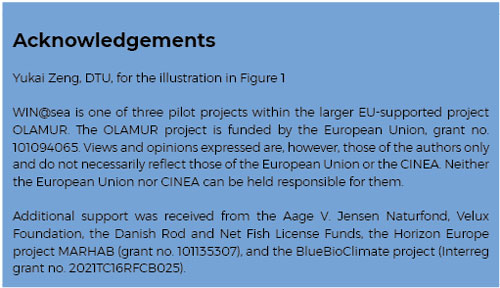
Authors
Yasmin Sassa Victor (s191311@student.dtu.dk) and Ana Liu Wu (s233315@student.dtu.dk), both DTU Aqua, are the joint primary authors of the article.
Annette Bruhn (anbr@bios.au.dk), Aarhus University; project leader WIN@Sea
Christian Riisager-Simonsen
(chrii@aqua.dtu.dk), DTU Aqua
Tim Wilms (tim.wilms@vattenfall.com), Vattenfall
Lars Emil Juel Andersen (leman@aqua.dtu.dk), DTU Aqua
Jon C. Svendsen (jos@aqua.dtu.dk), DTU Aqua
References
[1] European Commission. (n.d.). Offshore renewable energy. Retrieved from:
https://energy.ec.europa.eu/topics/renewable-energy/offshore-renewable-energy_en
[2] Glarou, M., Zrust, M., & Svendsen, J. C. (2020, May 8). Using Artificial-Reef -Knowledge to Enhance the Ecological Function of Offshore Wind Turbine Foundations: Implications for Fish Abundance and Diversity. Journal of Marine Science and Engineering, 8(332), 1–25.
DOI: 10.3390/jmse8050332
[3] Ibanez-Erquiaga, B., Baktoft, H., Mildenberger, T.K., Teilmann, J., Kleivane, L., Kornau, L.M., Agersted, M.D., Hüllert, S.M., & Svendsen, J.C. (2025, January 10). Increased fish abundance, biodiversity, and body size near a North Sea oil and gas platform. Marine Environmental Research, 204, 106959.
DOI: 10.1016/j.marenvres.2025.106959
[4] Przedrzymirska, J., Zaucha, J., Szefler, K., Michalak, M., Gawlikowska-Hueckel, K., & Calado, H. (2021). Multi-Use of the Sea as a Sustainable Development Instrument in Five EU Sea Basins. Sustainability, 13(15), 8159.
DOI: 10.3390/su13158159
[5] Schiffman, R. (2016, October 6). Can We Save the Oceans By Farming Them? Yale e360. Retrieved from:
https://e360.yale.edu/features/new_breed_of_ocean_farmer_aims_to_revive_global_seas
[6] van den Burg, S. W. K., Schupp, M. F., Depellegrin, D., Barbanti, A., & Kerr, S. (2020, August 30). Development of multi-use platforms at sea: Barriers to realising Blue Growth. Ocean Engineering, 217(107983).
DOI: 10.1016/j.oceaneng.2020.107983
[7] Wilms, T., Ibanez-Erquiaga, B., & Svendsen, J. C. (2023). Wind farms operating at sea: A sanctuary for marine fishes? Habitat, 27, 48-59.
https://dzs.dk/wp-content/uploads/2023/09/HABITAT27.pdf
[8] Xylia, M., Passos, M. V., Piseddu, T., & Barquet, K. (2023, May 19). Exploring multi-use platforms: A literature review of marine, multifunctional, modular, and mobile applications (M4s). Heliyon, 9, e16372.
DOI: 10.1016/j.heliyon.2023.e16372






